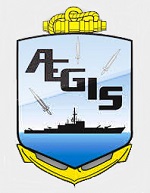Hobby Master HSP1001 US Navy Ticonderoga Class Guided Missile Cruiser - USS Ticonderoga (CG-47) (1:700 Scale)
"Damn the torpedoes. Full speed ahead!"
- Admiral Farragut sailing aboard his flagsphip Hartford while entering Mobile Bay, Alabama, August 23, 1864
 The Ticonderoga class of guided-missile cruisers is a class of warships in the United States Navy, first ordered and authorized in the 1978 fiscal year. The class uses passive phased-array radar and was originally planned as a class of destroyers. However, the increased combat capability offered by the Aegis Combat System and the AN/SPY-1 radar system, together with the capability of operating as a flagship, were used to justify the change of the classification from DDG (guided missile destroyer) to CG (guided-missile cruiser) shortly before the keels were laid down for Ticonderoga and Yorktown.
The Ticonderoga class of guided-missile cruisers is a class of warships in the United States Navy, first ordered and authorized in the 1978 fiscal year. The class uses passive phased-array radar and was originally planned as a class of destroyers. However, the increased combat capability offered by the Aegis Combat System and the AN/SPY-1 radar system, together with the capability of operating as a flagship, were used to justify the change of the classification from DDG (guided missile destroyer) to CG (guided-missile cruiser) shortly before the keels were laid down for Ticonderoga and Yorktown.
Ticonderoga-class guided-missile cruisers are multi-role warships. Their Mk 41 VLS can launch Tomahawk cruise missiles to strike strategic or tactical targets, or fire long-range antiaircraft Standard Missiles for defense against aircraft or anti-ship missiles. Their LAMPS III helicopters and sonar systems allow them to perform antisubmarine missions. Ticonderoga-class ships are designed to be elements of carrier battle groups or amphibious ready groups, as well as performing missions such as interdiction or escort. With upgrades to their AN/SPY-1 phased radar systems and their associated missile payloads as part of the Aegis Ballistic Missile Defense System, members of this class have, in successive tests, repeatedly demonstrated their proficiency as mobile anti-ballistic missile and anti-satellite weaponry platforms.
Of the 27 completed vessels, 19 were built by Ingalls Shipbuilding and eight by Bath Iron Works (BIW). All but one (Thomas S. Gates) of the ships in the class are named for noteworthy events in U.S. military history, and at least twelve share their names with World War II-era aircraft carriers. In 2016, 22 ships were still active and expected to serve for 35 years since commissioning.
Pictured here is a 1:700 scale replica of the Ticonderoga class guided missile cruiser, USS Ticonderoga (CG-47).
Sold Out!
Dimensions:
Length: 11-inches
Release Date: July 2018
 Historical Account: "Defending the Fleet" - The Aegis Combat System on the Ticonderoga class guided missile cruiser is an integrated naval weapons system developed by the Missile and Surface Radar Division of RCA, and now produced by Lockheed Martin. It uses powerful computer and radar technology to track and guide weapons to destroy enemy targets.
Historical Account: "Defending the Fleet" - The Aegis Combat System on the Ticonderoga class guided missile cruiser is an integrated naval weapons system developed by the Missile and Surface Radar Division of RCA, and now produced by Lockheed Martin. It uses powerful computer and radar technology to track and guide weapons to destroy enemy targets.
Initially used by the United States Navy, Aegis is now used also by the Japan Maritime Self-Defense Force, Spanish Navy, Royal Norwegian Navy, and Republic of Korea Navy. Over 100 Aegis-equipped ships have been deployed in five navies worldwide. The Royal Australian Navy selected the Aegis system for placement on its new Air Warfare Destroyers, and it is part of NATO's European missile defense system.
The Aegis Combat System (ACS) is an advanced command and control (command and decision, or C&D, in Aegis parlance) and weapon control system (WCS) that uses powerful computers and radars to track and guide weapons to destroy enemy targets.
The ACS is composed of the Aegis Weapon System (AWS), the fast-reaction component of the Aegis Anti-Aircraft Warfare (AAW) capability, along with the Phalanx Close In Weapon System (CIWS), and the Mark 41 Vertical Launch System. Mk 41 VLS is available in different versions that vary in size and weight. There are three lengths: 209 in (5.3 m) for the self-defense version, 266 in (6.8 m) for the tactical version, and 303 in (7.7 m) for the strike version. The empty weight for an 8-cell module is 26,800 lb (12,200 kg) for the self-defense version, 29,800 lb (13,500 kg) for the tactical version, and 32,000 lb (15,000 kg) for the strike version, thus incorporating anti-submarine warfare (ASW) systems and Tomahawk Land Attack Cruise Missiles (TLAM). Shipboard torpedo and naval gunnery systems are also integrated.





 Great Model and Great service
Great Model and Great service 





![Desert Warfare Bundle: US Oshkosh Defense M1070 Heavy Equipment Transporter with M1000 Semi-Trailer Plus a US M1A2 SEP Abrams Main Battle Tank with TUSK I Survival Kit [Desert Scheme] (1:72 Scale)](http://cdn4.volusion.store/qh9e9-jdqv9/v/vspfiles/photos/PZK12206DW-1.jpg?v-cache=1740197136)

![Israeli Defense Force Lockheed-Martin F-35A "Adir" Joint Strike Fighter - "Grey 921", 140 Squadron "Golden Eagle", Nevatim Airbase, Beersheba, Israel, 2021 [Low-Vis Scheme] (1:72 Scale)](http://cdn4.volusion.store/qh9e9-jdqv9/v/vspfiles/photos/HA4432-1.jpg?v-cache=1740197136)

